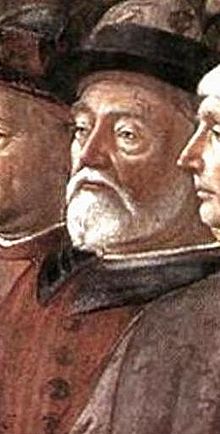John Argyropulos
| John Argyropoulos Ἰωάννης Ἀργυρόπουλος |
|
|---|---|

John Argyropoulos as depicted by Domenico Ghirlandaio in 1481 in the Vocation of the Apostles fresco in the Sistine Chapel, Rome.
|
|
| Born |
Ioannis Argiropoulos c. 1415 Constantinople, Byzantine Empire |
| Died | 1487 Florence, Republic of Florence |
| Education |
University of Padua (Theol. Dr., 1444) |
| Era | Renaissance philosophy |
| Region | Western philosophy |
| School |
Renaissance philosophy Aristotelianism |
| Institutions | University of Constantinople |
|
Main interests
|
Rhetoric, theology |
|
Influences
|
|
John Argyropoulos (Greek: Ἰωάννης Ἀργυρόπουλος Ioannis Argiropoulos; Italian: Giovanni Argiropulo; surname also spelt Argyropulus, or Argyropulos, or Argyropulo; c. 1415 – 26 June 1487) was a lecturer, philosopher and humanist, one of the émigré Greek scholars who pioneered the revival of Classical learning in 15th-century Italy.
He translated Greek philosophical and theological works into Latin besides producing rhetorical and theological works of his own. He was in Italy for the Council of Florence during 1439–1444, and returned to Italy following the fall of Constantinople, teaching in Padua, Florence and Rome from 1456 until his death.
John Argyropoulos was born in c. 1415, in Constantinople. He was Greek.
Argyropoulos studied theology and philosophy in Constantinople. As a teacher in Constantinople, Argyropulos had amongst his pupils the scholar Constantine Lascaris. He was an official in the service of one of the rulers of the Byzantine Morea and in 1439 was a member of the Byzantine delegation to the Council of Florence, when they accepted Catholicism and abjured Greek Orthodoxy. In 1443/4, he received a Doctor of Theology degree from the University of Padua before returning to Constantinople.
When Constantinople fell in 1453, he left it for the Peloponnesus and in 1456, took refuge in Italy, where he worked as a teacher in the revival of Greek philosophy in the universities of Padua, Florence and Rome and as head of the Greek department at Florence’s ‘Florentine Studium’ university. In 1471, on the outbreak of the plague, he moved to Rome, where he continued to act as a teacher of Greek till his death.
...
Wikipedia
